Fascinated with graphics and shaders, I took it upon myself to learn the insides of OpenGL to learn how to program shaders from scratch! With the combination of Three.js and GLSL, I taught myself the very basics of vertex and fragment shaders to render the very object on the left. Applying shaders and materials in Blender streamlines this entire process as a bunch of nodes and connections you piece together like logic gates. You want a glossy surface with anisotropic faces? Shift + D "principled bsdf," slide a few knobs, and done! In GLSL? Well, you first have to take the dot product of the surface normal to the ray of light radiating off an emission source to calculate the amount of absorption, deflection, transmission, and then repeat this for every vertex in the mesh and...

Start with z-dependent stripes

Apply vornoi distortion + smoothing

Apply pattern to vertex heights
